| Article ID | Journal | Published Year | Pages | File Type |
|---|---|---|---|---|
| 1532493 | Materials Science and Engineering: R: Reports | 2010 | 10 Pages |
Abstract
Relying on the piezopotential created in ZnO under straining, nanogenerators, piezotronics and piezo-phototronics developed based on laterally bonded nanowires on a polymer substrate have been reviewed. The principle of the nanogenerator is a transient flow of electrons in external load as driven by the piezopotential created by dynamic straining. By integrating the contribution made by millions of nanowires, the output voltage has been raised to 1.2Â V. Consequently, self-powered nanodevices have been demonstrated. This is an important platform technology for the future sensor network and the internet of things. Alternatively, the piezopotential can act as a gate voltage that can tune/gate the transport process of the charge carriers in the nanowire, which is a gate-electrode free field effect transistor (FET). The device fabricated based on this principle is called the piezotronic device. Piezo-phototronic effect is about the tuning and controlling of electro-optical processes by strain induced piezopotential. The piezotronic, piezophotonic and pieozo-phototronic devices are focused on low frequency applications in areas involving mechanical actions, such as MEMS/NEMS, nanorobotics, sensors, actuators and triggers.
Related Topics
Physical Sciences and Engineering
Materials Science
Electronic, Optical and Magnetic Materials
Authors
Zhong Lin Wang, Rusen Yang, Jun Zhou, Yong Qin, Chen Xu, Youfan Hu, Sheng Xu,
